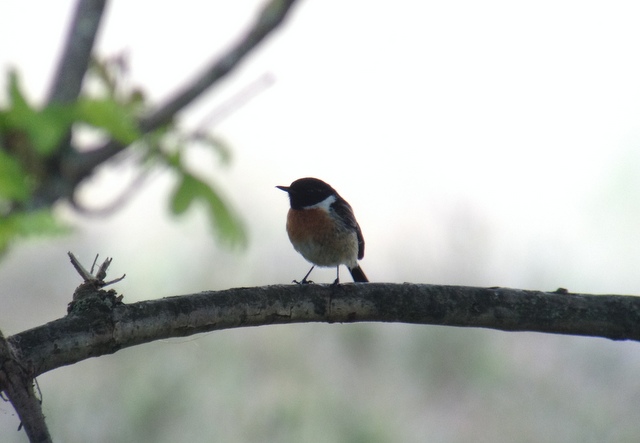Day 3 of a long weekend of tours. The weather forecast for today was terrible – rain and wind. But thankfully it turned out to be nowhere near as bad as forecast, we mostly dodged the showers, and we still had a cracking day out with a total of 99 species seen and heard during the day!
We headed to Titchwell first. With heavy rain forecast, we thought we could get out of the rain and in the hides and at least still see some birds. There had been some rain overnight, but it was not even raining when we arrived. And the car park was empty. Empty on the Sunday of half term week – unheard of!
 Titchwell – an empty car park of Sunday of half term week
Titchwell – an empty car park of Sunday of half term week
We walked out to the visitor centre and had just stopped to look at the feeders when one of the group spotted a Barn Owl hunting over the grazing meadow beyond. It had presumably struggled to feed in the rain overnight and was making the most of the dryer weather. We walked out onto the main path and could see it out over the grass. It flew round in front of us several times, with its eyes down focused on the ground below, hovering periodically. Once it dropped down but came up again empty-taloned. Stunning birds. At one point a cracking male Marsh Harrier flew across just behind it as well. It was non-stop action this morning!
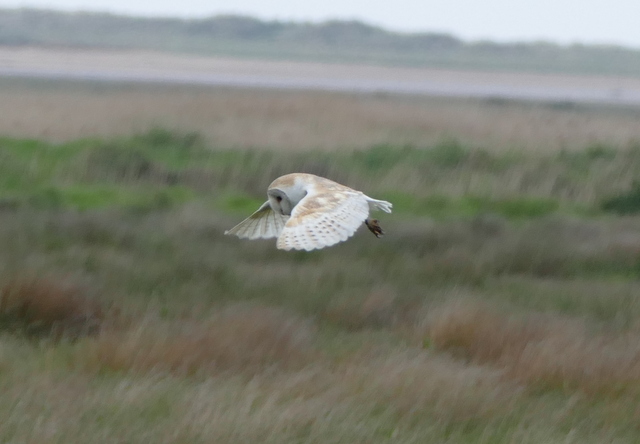 Barn Owl – hunting over the Thornham grazing meadow this morning
Barn Owl – hunting over the Thornham grazing meadow this morning
There were several Reed Warblers singing on the walk out and a couple of Sedge Warblers as well, but as we got in sight of the reedbed pool we could see several warblers flicking about on the edge of the reeds by the pools next to the main path. One flew across and we could see its rich, dark chestnut upperparts – a Cetti’s Warbler. As we stopped to watch, we realised that there were actually at least two Cetti’s Warblers collecting food on the edge of the reeds and carrying it back into the bushes. Another was singing nearby and in response the male Cetti’s Warbler flew up to the brambles and perched up singing. Great views of this usually so elusive species. There were several Reed and Sedge Warblers flying around here as well and we got good views of those too.
The reedbed pool held its usual good selection of diving ducks. There were several Red-crested Pochards, including a nice close pair with the male flaunting his bright orange punk haircut. There were also a few Common Pochard for comparison and a couple of Tufted Duck. A Little Grebe disappeared into the reeds.
 Red-crested Pochard – check out that haircut
Red-crested Pochard – check out that haircut
It was a bit damp, but still not raining, as we made for Island Hide. The first thing we saw was the throng of Icelandic Black-tailed Godwits out on the freshmarsh, over 120 of them today, in various plumages from winter to almost full summer, grey to bright rusty orange. From this side of the marsh, there looked to be a slightly disappointing selection of waders here today – but later on we could see how first impressions could be deceptive. However, there were the usual Avocets to admire.
 Avocet – the obligatory Titchwell photo
Avocet – the obligatory Titchwell photo
The prize for the most out-of-place bird went to the White-faced Whistling Duck which was out on the freshmarsh. Native to Africa and South America, it is a common bird in captivity and had presumably escaped from a collection somewhere. It didn’t look too pleased to be here. Three Barnacle Geese also flew in and landed on the freshmarsh. We do sometimes get birds from a presumed wild origin, most often arriving with Pink-footed Geese in the winter, but there is a large feral population so that is the most likely origin for today’s birds. Plastic fantastic today!
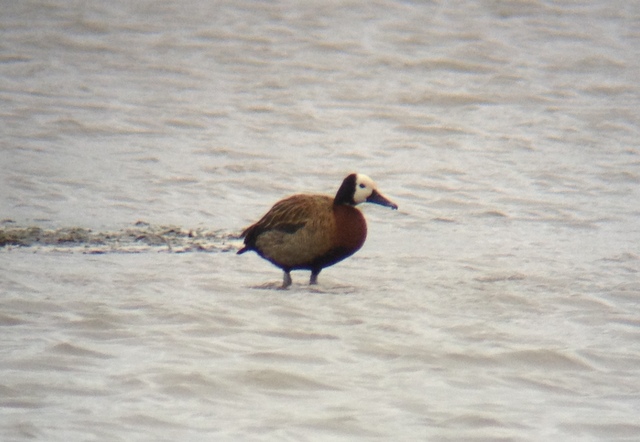 White-faced Whistling Duck – presumably an escapee
White-faced Whistling Duck – presumably an escapee
There were lots of other ducks to see. Most of the species which are common over the winter have already departed, but the odd straggler sometimes remains. The single female Pintail which has been lingering here recently was still present today. There was also just one female Teal, the first we have seen here for a while. We saw lots of both species more regularly over the winter months. As well as these lonely individuals, there were several families of Mallards with ducklings, and still quite a few Shoveler and Gadwall.
 Shoveler – this smart drake dropped down in front of the hide briefly
Shoveler – this smart drake dropped down in front of the hide briefly
There have been several 1st summer Little Gulls out on the freshmarsh for some time now. Numbers have varied, but recent counts have been as high as 11. We had no trouble finding Little Gulls today, but there were no more than 4 to start with. They were mostly walking around on the islands, feeding. At one point, we had a Little Gull and a Black-headed Gull side by side in the scope, which really highlighted how ‘Little’ they are. It was only later in the day, as we walked back from the beach, that we found more of them as a bigger group flew in and started hawking for insects over the water, calling. At that point we could count a minimum of 9 Little Gulls, all 1st summer birds.
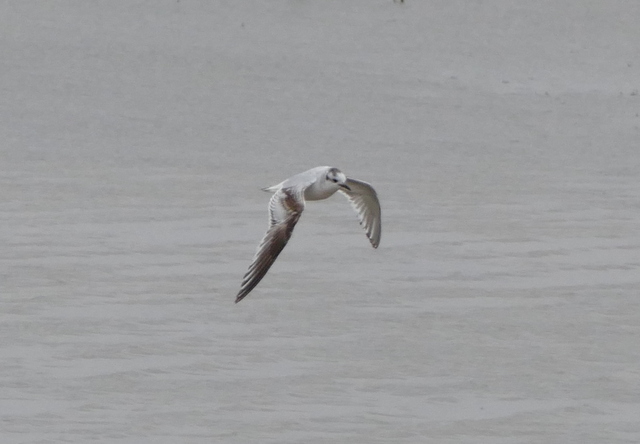 Little Gull – one of the 9+ 1st summers on the freshmarsh today
Little Gull – one of the 9+ 1st summers on the freshmarsh today
It had brightened up a little as we walked from Island Hide round to Parrinder Hide, but we could see darker clouds and rain moving in from the west. We got our game plan just right, as were safely in the hide as it passed over us. It got a bit misty and grey for a time, but it didn’t stop us seeing lots of birds – and only sitting in the Parrinder Hide did we realise how many waders were actually out on the islands.
 Snipe – appeared from the dense vegetation to feed on the bank
Snipe – appeared from the dense vegetation to feed on the bank
A Common Snipe was one of the first birds we picked up. It was flushed out of the dense vegetation below the bank by a family of Mallard and proceeded to skulk around before getting a bit of confidence and coming out to feed on the mud. Such cryptically patterned birds, they can blend in so it was great to see it out in the open. The longer we looked, the more we saw. A couple of Dunlin appeared from behind one of the islands, sporting their summer black bellies. A Common Sandpiper disappeared into the far corner along the bank, bobbing its tail, before it later flew out and perched on one of the piles of bricks. A chestnut coloured summer plumage Sanderling appeared briefly on the shore of one of the islands.
There have been several Little Ringed Plovers in front of Parrinder Hide in recent weeks, but the first plover we picked up today was a Ringed Plover. After a while, we realised there were several feeding unobtrusively around the margins. A closer look confirmed these were all Tundra Ringed Plovers, of the smaller, darker tundrae race which passes through here on its way north at this time of year. Even better, a slightly larger, slightly paler Ringed Plover then flew in. It was aggressive towards the tundrae race birds, trying to chase them off. This was one of the more southern race birds (hiaticula), which is the race which breeds here. There were also several Little Ringed Plovers as usual – their golden yellow eye rings gave them away.
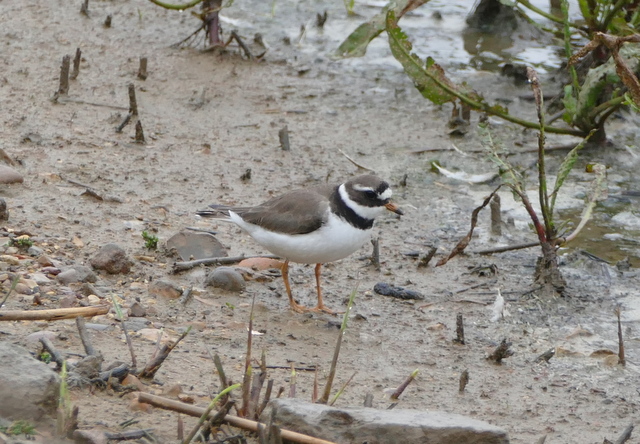 Tundra Ringed Plover – two races of Ringed Plover were present today
Tundra Ringed Plover – two races of Ringed Plover were present today
Once it brightened up a little again we decided to head out towards the beach. The Volunteer Marsh and Tidal Pools were quiet again, but we did manage to find a single Brent Goose out on the saltmarsh opposite. The bigger group which had been lingering here until recently appears finally to have departed back to Russia. We had heard a Cuckoo singing distantly while we were in Parrinder Hide but as we arrived at the beach another one flew in over the sand and disappeared over the dunes.
There was a good variety of waders on the rocks below the beach to add to the day’s list. A handful of Bar-tailed Godwit were all in winter plumage still, as were a couple of Grey Plover. The latter flew round at one point, flashing their black armpits. The Turnstones were keeping to the shelter on the far side of the rocks, but one did walk up onto the top so we could get a good look at it. Several more Sanderling were feeding on the beach as well, in a mixture of plumages.
The sea has been fairly quiet of late, but a single Great Crested Grebe was just offshore today. While we were looking at it, we could see a long line of black shapes much further out – a big raft of Common Scoter. There were also a few Sandwich and Common Terns flying around out over the sea.
We walked back via the Meadow Trail, where we paused briefly to admire all the Southern Marsh Orchids now coming out and several Azure and Blue-tailed Damselflies hiding in the grass on the meadow. The detour out to Patsy’s Reedbed added Bullfinch calling from the bushes. A pair of Little Grebes appeared to be nest building below the screen. Most of the Red-crested Pochards were loafing around here as usual.
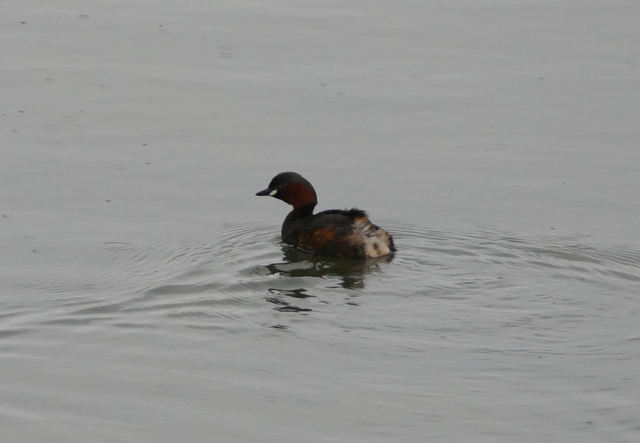 Little Grebe – one of the pair on Patsy’s Reedbed
Little Grebe – one of the pair on Patsy’s Reedbed
While we were looking out from the screen, we hadn’t noticed a squally shower sneaking up behind us. As it started to rain, we made a quick dash for the safety of Fen Hide while it passed over us. And that was the only time we really got rained on today. Once the rain stopped, we headed back for lunch. Unfortunately there was no sign of the Spotted Flycatcher which had been seen in the car park earlier.
After lunch, we drove along the coast to Holme. We had wanted to try to see the Turtle Doves in the paddocks, but it was very exposed and windy there. The best we could do was a Common Whitethroat and a Linnet having a bath in a puddle. Otherwise, it was disappointingly quiet. Rather than press on into the dunes, we decided on a quick change of plan and headed somewhere more sheltered.
We carried on along the coast and round the corner of the Wash, heading south to Dersingham Bog. It was much better out of the wind, in the lee of the trees and the ‘cliff’. Almost as soon as we got out of the car, we could hear a Garden Warbler singing. There were several Blackcaps singing too. Down in the Bog, we followed the call of a Stonechat and found a family party. We could see the male and female at first and from the way they were behaving we knew they had young stashed nearby. As we walked past them along the path, the streaky juvenile Stonechats came out and we could see they had been colour-ringed in various combinations.
While we were watching the Stonechats, we heard the distinctive song of a Tree Pipit. We followed the sound and found it perched in the top of a small tree high up on the hillside above us. We got a pretty good look at it in the scope. Then it took off singing and flew over the way we had just come. We walked back and it flew up again, parachuting down in the top of an oak tree right above our heads. We got great views of it this time.
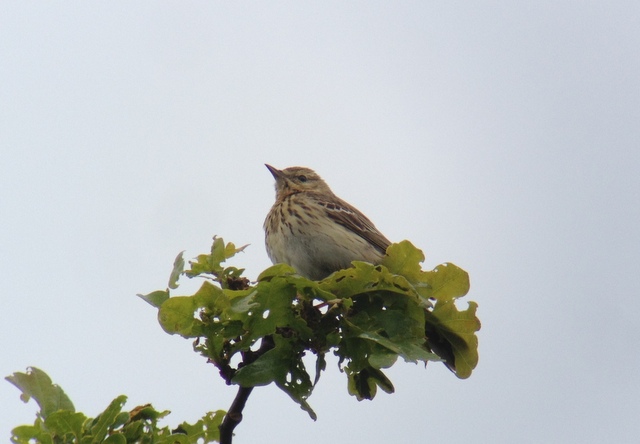 Tree Pipit – parachuted into the top of an oak tree above our heads
Tree Pipit – parachuted into the top of an oak tree above our heads
As we walked on round, a Red Kite came out of the trees and circled lazily round us over the Bog. Up in the trees, we came across several tits feeding, including our first Coal Tit of the day. A Nuthatch was climbing up and down a Pine Tree. But the surprise here was a Firecrest singing. Unfortunately we couldn’t see it in the dense fir trees, our way towards it blocked by thick rhododendrons, but a Goldcrest singing nearby allowed us a great comparison of the two songs.
Once we got back to the car, it was time to start making our way back to base. However, we still had enough time for a couple of quick stops en route. Taking a detour round via the seafront at Hunstanton, we stopped to watch the Fulmars pulling aerobatic manoeuvres above the cliffs. It was still very windy, and with the wind blowing in from the wash, they seemed to be enjoying the resulting updraft along the cliff face.
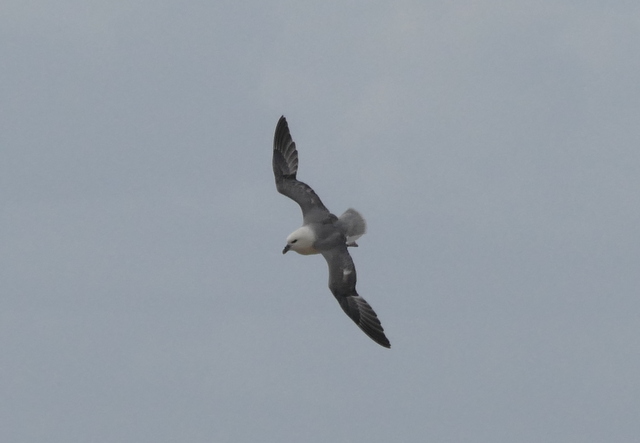 Fulmar – aerobatic moves in the strong winds today
Fulmar – aerobatic moves in the strong winds today
Heading back along the north coast, we diverted up to the drying barns at Choseley. A Corn Bunting was singing from the wires – we listened to the sound like jangling keys – and was joined by a second. A smart male Yellowhammer was bathing in a puddle. A Grey Partridge was calling from behind a hedge and a couple of Brown Hares ran off as we drove along. Someone had poured several piles of grain out on the concrete pad by the drying barns and the birds had arrived to take advantage – another Corn Bunting, lots of Yellowhammers, Linnet, Chaffinches and a couple of Stock Doves.
 Corn Bunting – singing on the wires at Choseley
Corn Bunting – singing on the wires at Choseley
As we drove back home, we reflected on what a great day we had enjoyed, compared to our expectations having seen the weather forecast this morning. It really is worth going out whatever the weather, and certainly whatever the forecaster says the weather is going to be!
